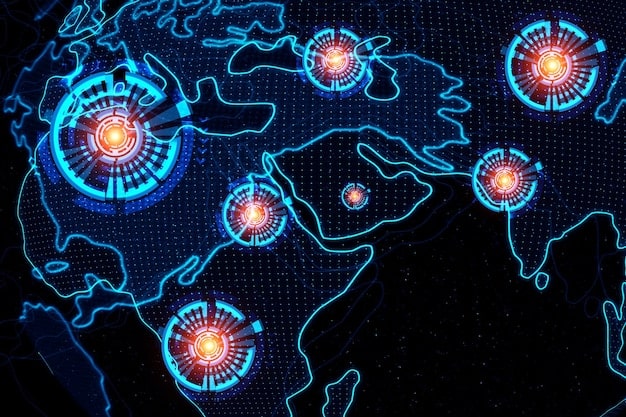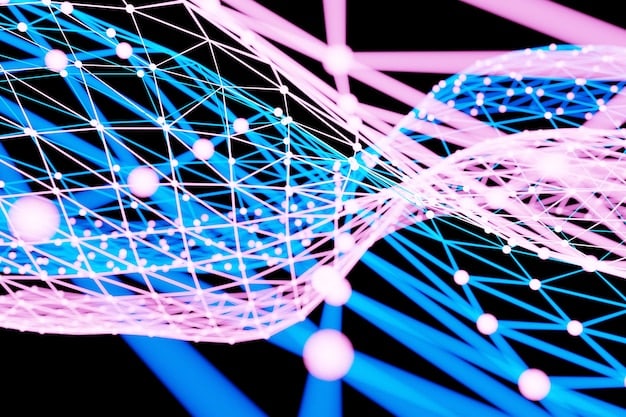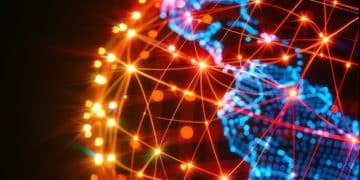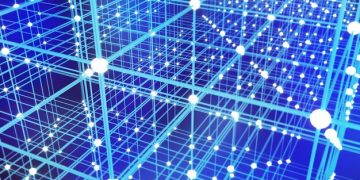The Future of Cybersecurity: Preparing for Tomorrow’s Threats

The future of cybersecurity requires proactive strategies and investments in innovative solutions to combat increasingly sophisticated and frequent cyberattacks, ensuring data protection and operational resilience for individuals and organizations alike.
The digital landscape is constantly evolving, and with it, so are the threats we face in cyberspace. Understanding the future of cybersecurity: preparing for the next generation of threats and investing in innovative solutions is no longer optional; it’s a necessity for every individual, business, and government entity.
Understanding the Evolving Threat Landscape
The cybersecurity threat landscape is in a perpetual state of flux, becoming more complex and challenging to navigate. As technology advances, so do the methods employed by malicious actors, demanding that we stay ahead of the curve.
Sophistication of Attacks
Cyberattacks are growing increasingly sophisticated, utilizing advanced techniques such as artificial intelligence (AI) and machine learning (ML) to bypass traditional security measures. This requires a shift towards more intelligent and adaptive defense mechanisms.
Increased Frequency and Scale
The frequency and scale of cyberattacks have also seen a significant rise. From ransomware attacks crippling critical infrastructure to data breaches exposing sensitive information, the impact of these attacks is far-reaching and costly.

Emerging Attack Vectors
New attack vectors are constantly emerging, exploiting vulnerabilities in Internet of Things (IoT) devices, cloud services, and supply chains. Addressing these vulnerabilities requires a holistic approach to security that considers all potential points of entry.
- AI-Powered Attacks: Malicious actors use AI to automate and enhance phishing campaigns, malware development, and vulnerability exploitation.
- IoT Exploitation: The proliferation of IoT devices presents numerous security challenges due to their inherent vulnerabilities and lack of security updates.
- Supply Chain Attacks: Targeting vulnerabilities in the supply chain allows attackers to compromise multiple organizations through a single point of entry.
The evolving threat landscape necessitates a proactive and adaptive approach to cybersecurity. Organizations must invest in advanced technologies, threat intelligence, and skilled personnel to effectively mitigate these emerging threats.
The Rise of AI and Machine Learning in Cybersecurity
Artificial intelligence (AI) and machine learning (ML) are transforming the field of cybersecurity, offering new opportunities to detect, prevent, and respond to cyber threats. These technologies can analyze vast amounts of data to identify patterns and anomalies that would be impossible for humans to detect manually.
AI-Powered Threat Detection
AI algorithms can be trained to identify malicious behavior and anomalies in network traffic, user activity, and system logs. This enables faster and more accurate threat detection compared to traditional rule-based systems.
Automated Incident Response
AI can automate incident response processes, such as isolating infected systems, blocking malicious traffic, and patching vulnerabilities. This reduces the time it takes to respond to attacks, minimizing the potential damage.

Predictive Threat Intelligence
AI can analyze historical data and threat intelligence feeds to predict future attacks and identify potential vulnerabilities. This allows organizations to proactively address security gaps and strengthen their defenses.
- Behavioral Analysis: AI algorithms can learn normal user and system behavior, detecting deviations that may indicate malicious activity.
- Anomaly Detection: AI can identify unusual patterns in network traffic and system logs, alerting security teams to potential threats.
- Automated Vulnerability Scanning: AI can automate the process of scanning systems for known vulnerabilities, ensuring that they are patched promptly.
The integration of AI and ML into cybersecurity solutions is essential for staying ahead of sophisticated cyber threats. These technologies enable organizations to detect and respond to attacks more quickly and effectively, reducing the risk of data breaches and other security incidents.
Securing the Internet of Things (IoT)
The Internet of Things (IoT) has brought about a revolution in connectivity, with billions of devices now interconnected in our homes, workplaces, and cities. However, this proliferation of devices also presents significant cybersecurity challenges.
Vulnerabilities in IoT Devices
Many IoT devices are designed with minimal security features, making them vulnerable to cyberattacks. These vulnerabilities can be exploited by malicious actors to gain access to sensitive data, disrupt critical services, or launch large-scale attacks.
Lack of Security Updates
Many IoT device manufacturers fail to provide regular security updates, leaving devices exposed to known vulnerabilities for extended periods. This makes them easy targets for attackers who can exploit these vulnerabilities to compromise devices and networks.
Importance of Security by Design
Implementing security by design principles is crucial for ensuring the security of IoT devices. This involves incorporating security features into the design and development process, rather than adding them as an afterthought.
- Secure Boot: Ensures that only authorized software can run on the device, preventing the execution of malicious code.
- Encryption: Protects sensitive data transmitted and stored on the device from unauthorized access.
- Authentication: Verifies the identity of users and devices accessing the network, preventing unauthorized access.
Securing the IoT requires a multifaceted approach that involves device manufacturers, service providers, and end-users. Implementing security by design principles, providing regular security updates, and educating users about security best practices are essential steps for mitigating the risks associated with IoT devices.
Cloud Security Best Practices
Cloud computing has become an integral part of modern IT infrastructure, offering scalability, flexibility, and cost savings. However, migrating to the cloud also introduces new security challenges that must be addressed.
Shared Responsibility Model
Cloud security is a shared responsibility between the cloud provider and the customer. The cloud provider is responsible for securing the infrastructure, while the customer is responsible for securing their data, applications, and operating systems.
Identity and Access Management (IAM)
Implementing robust identity and access management (IAM) controls is essential for securing cloud environments. This involves controlling who has access to what resources and ensuring that access is granted based on the principle of least privilege.
Data Encryption and Protection
Encrypting data both in transit and at rest is crucial for protecting sensitive information in the cloud. Data loss prevention (DLP) tools can also be used to prevent sensitive data from leaving the cloud environment.
- Multi-Factor Authentication (MFA): Adds an extra layer of security by requiring users to provide multiple forms of authentication.
- Role-Based Access Control (RBAC): Grants access to resources based on a user’s role within the organization.
- Regular Security Audits: Helps identify and address security vulnerabilities in the cloud environment.
Adhering to cloud security best practices is essential for ensuring the confidentiality, integrity, and availability of data in the cloud. Organizations must implement robust security controls, monitor their cloud environments for threats, and stay informed about emerging security risks.
The Role of Cybersecurity Professionals
Cybersecurity professionals play a crucial role in protecting organizations from cyber threats. These individuals possess the skills and expertise necessary to identify, prevent, and respond to cyberattacks.
Skills and Expertise
Cybersecurity professionals require a diverse set of skills and expertise, including knowledge of network security, cryptography, incident response, and risk management. They must also stay up-to-date with the latest threats and security technologies.
Demand for Cybersecurity Professionals
The demand for cybersecurity professionals is growing rapidly, driven by the increasing frequency and sophistication of cyberattacks. Organizations are struggling to find and retain qualified cybersecurity personnel, creating a significant workforce gap.
Training and Education
Investing in training and education is essential for developing a skilled cybersecurity workforce. Educational institutions and industry organizations are offering a variety of cybersecurity certifications and training programs to meet the growing demand.
- Certified Information Systems Security Professional (CISSP): A globally recognized certification for cybersecurity professionals.
- Certified Ethical Hacker (CEH): A certification for professionals who assess the security of systems by simulating attacks.
- Security+: A entry-level certification that covers fundamental security concepts and technologies.
The cybersecurity profession is constantly evolving, requiring professionals to continuously learn and adapt to new threats and technologies. Investing in training and education is essential for building a skilled and resilient cybersecurity workforce.
Investing in Innovative Cybersecurity Solutions
To effectively address the evolving threat landscape, organizations must invest in innovative cybersecurity solutions. These solutions leverage advanced technologies such as AI, ML, and blockchain to provide enhanced security capabilities.
Threat Intelligence Platforms
Threat intelligence platforms aggregate and analyze threat data from various sources to provide organizations with actionable insights into emerging threats. This enables them to proactively address security gaps and strengthen their defenses.
Security Orchestration, Automation, and Response (SOAR)
SOAR platforms automate incident response processes, enabling security teams to respond to attacks more quickly and effectively. These platforms can also integrate with other security tools to provide a more coordinated and comprehensive security posture.
Blockchain for Cybersecurity
Blockchain technology can be used to enhance cybersecurity in various ways, such as securing data, verifying identities, and preventing fraud. Blockchain’s decentralized and immutable nature makes it resistant to tampering and attack.
- Endpoint Detection and Response (EDR): Provides real-time monitoring and analysis of endpoint activity to detect and respond to threats.
- Security Information and Event Management (SIEM): Collects and analyzes security logs from various sources to identify and respond to security incidents.
- Zero Trust Security: A security model that assumes no user or device is trusted by default and requires verification before granting access to resources.
Investing in innovative cybersecurity solutions is essential for staying ahead of the evolving threat landscape. Organizations must evaluate their security needs and invest in solutions that provide the best protection against the threats they face.
| Key Point | Brief Description |
|---|---|
| 🛡️ Evolving Threats | Cyberattacks are becoming more sophisticated and frequent, requiring advanced security measures. |
| 🤖 AI in Cybersecurity | AI and machine learning enhance threat detection, automate incident response, and predict future attacks. |
| 🌐 Securing IoT | IoT devices need security by design and regular updates to prevent exploitation. |
| ☁️ Cloud Security | Cloud security requires shared responsibility, strong IAM, and data encryption. |
FAQ
▼
One major challenge is the increasing sophistication of cyberattacks, with attackers using AI and machine learning to evade traditional security measures. Additionally, the shortage of skilled cybersecurity professionals poses a significant hurdle.
▼
AI and ML can analyze vast amounts of data to detect anomalies, automate incident response, and predict future attacks. This enables faster and more accurate threat detection and response.
▼
Best practices include implementing security by design, providing regular security updates, and educating users about security best practices. Secure boot, encryption, and authentication are also crucial.
▼
The cloud provider is responsible for securing the infrastructure, while the customer is responsible for securing their data, applications, and operating systems. Both parties must work together to ensure a secure cloud environment.
▼
Organizations can invest in training and education programs, partner with educational institutions, and offer competitive salaries and benefits to attract and retain skilled cybersecurity professionals. Certification support also helps.
Conclusion
As cyber threats continue to evolve, it is crucial for individuals, businesses, and governments to prioritize cybersecurity. By understanding emerging threats, leveraging innovative solutions, and investing in skilled professionals, we can create a more secure digital future.





